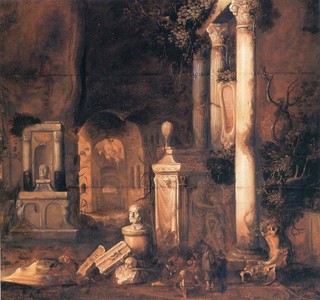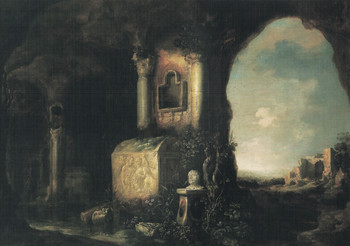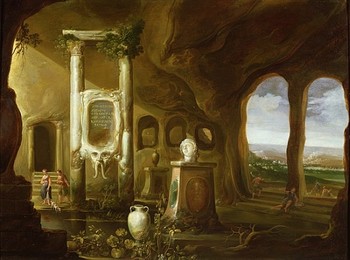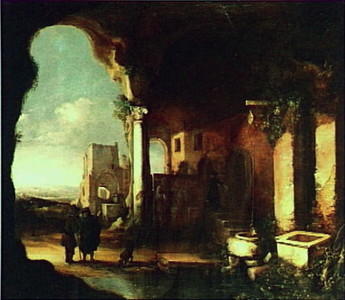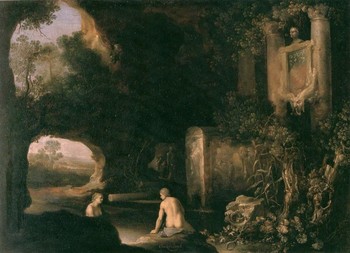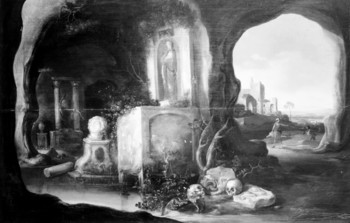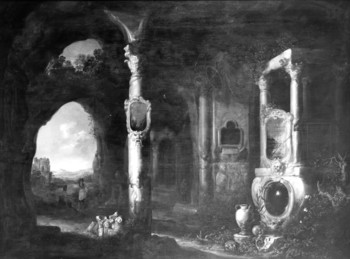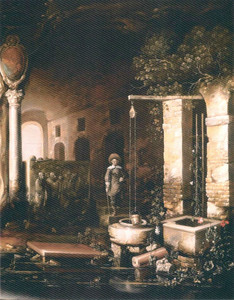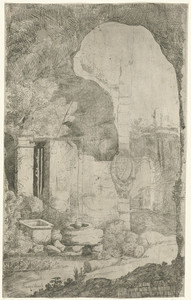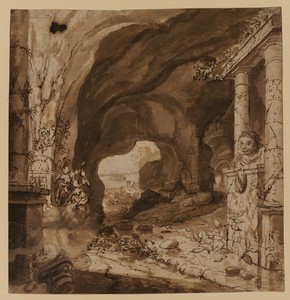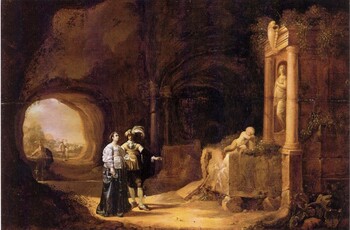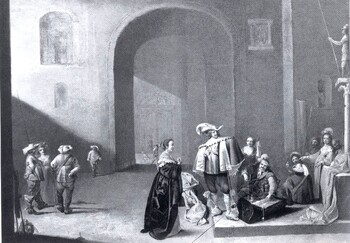12.500 €
A draughtsman and other travellers in a grotto amidst Roman monuments
Oil on canvas : 90,4 X 125,0 cm
Unsigned
Frame : 102,8 X 138,4 cm
Our painting is registered at the RKD, The Hague under the number 0000156090
In short
Charles de Hooch was an early 17th century specialist of Roman ruins and Vanitas symbols set in caverns. He was born in The Hague and was active during the last ten years of his life in Utrecht.
About Charles Cornelisz. de Hooch
Dutch painter
The Hague circa 1577– 1638 Utrecht
Painter of genre scenes and of domestic and Italianate landscapes.
It is not known whom de Hooch studied under, but he seems to have been influenced by Esaias van de Velde, Bartholomeus Breenbergh and Pieter van Laer.
Our painter is documented in Utrecht between 1628 and his premature death only ten years later.
- De Hooch must have lived here already before 1628 because that year he presented a painting to the hospital of Saint Job (het Sint Jobs Gasthuis) in Utrecht. During the 17thcentury it was a habit that every year a painter from Utrecht would present a painting for the hospital’s governors’ room (regentenkamer).
- He married in Utrecht in 1629.
- He became a member of the Utrecht Painter’s Guild of Saint Luke from the year 1633/34 onwards.
Charles de Hooch used to be erroneously mentioned as the father of the famous Rotterdam-born genre painter Pieter de Hooch (1629 – 1684 or later).
But Charles was probably the father or possibly the uncle of David de Hooch, who was strongly influenced by him, painting Italianate landscapes and a few grotto interiors. David was active between 1639 and circa 1655.
We should finally also mention Horatius de Hooch, whom dated works are known by between 1652 and 1686, and who also painted Southern landscapes with ruins.
About our painting
It is not known if de Hooch ever visited Italy. If so it must have been at a younger age, before 1628.
De Hooch specialized in Dutch and Italianate landscapes, but he is foremost known for his grotto interiors. A. Blankert in his catalogue of 17th century Italianate Dutch painters, 1965, describes them as “spooky lit grotto’s where in an unreal, almost surreal way are grouped Vanitas symbols”. I find them very attractive. Of course de Hooch’s approach of Roman art is very personal, very poetic, a bit strange. Judging by his paintings one can hardly believe he ever saw Roman ruins, columns or sculptures in real, but that he must have been inspired by paintings, drawings, engravings and descriptions of others. Many Utrecht painters visited Italy and Rome. During the 17th century Italy's landscapes, antique culture and monuments, its warm Southern light and its lively population formed a source of inspiration for numerous Northern artists, especially for Dutch and Flemish painters.
Several Dutch painters, such as Charles and David de Hooch, Abraham van Cuylenborch, Rombout van Troyen or Petrus van Hattich specialised in so-called grotto interiors.
Others like Cornelis van Poelenburch, Dirck Stoop and Willem van Bemmel regularly chose these mysterious, somewhat melodramatic surroundings for their paintings.
The figures within the grotto scenes were either mythological (Diana and her nymphs) or contemporary figures (visitors, shepherds).
The inventor of this new subject must have been Cornelis van Poelenburch, who had returned from a stay in Italy (Rome: 1617 – 1625 and Florence: circa 1625 – 1626) to his native Utrecht in 1627.
Why did Dutch painters choose, from all possible Italian places and subjects, caves as a subject? Italy is not particularly well-known for its caves filled with Roman ruins and tombs.
But then one must think of ancient ruins discovered between the late 15th century and the start 17th century during “archaeological” excavations, such as:
- the remains of the Domus Aurea of Nero on the Palatine Hill in Rome,
- the huge temple of Fortuna Primigenia under the town centre of Palestrina,
- the Nymphaeum at Hadrian’s Villa in Tivoli,
- the catacombs in and just outside Rome.
Another reason could be that in 16th and 17th century Italian shepherd plays set in Arcadia, nymphs, satyrs and even shepherds lived in caverns. The final of the in 1589 published and all over Europe immensely popular “Il pastor fido” from Giovanni Battista Guarini (1538 – 1612) is also set in a grotto.
De Hooch’s grotto interiors are all about vanity and decay. The scenery is not just decorative and beautiful, it is meant to inspire its viewers to wonder about deeper religious and philosophical ideas, to meditate about death and resurrection, about the ephemeral character of life.
Typical of de Hooch’s grottos is the ruined, decayed state of the Roman monuments, often overgrown with shrubbery.
In 2005 Marijke de Kinkelder from the RKD at The Hague stated that the two figures at left, the draughtsman and the person to his left, have been possibly added to the original composition They would have been painted by an Utrecht staffage painter from the circle of Jacob Duck (circa 1600 – 1667).
Why should you buy this painting?
Because it is such an original, poetic composition.

